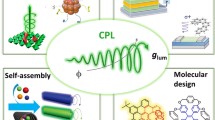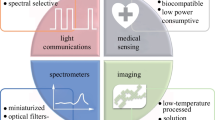Abstract
We developed photochemically controlled photonic crystals which may be useful in novel recordable and erasable memories and/or display devices. These materials can operate in the UV, visible or near IR spectral regions. Information is recorded and erased by exciting the photonic crystal with ∼ 360 nm UV light or ∼ 480 nm visible light. The recorded information is read out by measuring the photonic crystal diffraction wavelength. The active element of the device is an azobenzene functionalized hydrogel which contains an embedded crystalline colloidal array. UV excitation forms cis-azobenzene while visible excitation forms trans-azobenzene. Larger dipole moment of the cis-form results in decrease of the free energy of mixing which causes the hydrogel to swell and to red-shift the photonic crystal diffraction with a 36 s time constant. We also observed fast ms and sub-ms transient dynamics associated with convection due to heating of the medium by UV excitation. Convective motion of the medium stretches the PCCA for about 6 µs within which the convection decays and the elastic restoring force of the PCCA brings back the stretched PCCA to its equilibrium state with 33 µs time constant.
Similar content being viewed by others
References
J.D. Joannopoulos, R.D. Meade, J.N. Winn, Photonic Crystals: Molding the Flow of Light, Princeton University Press, New York, 1995.
T.F. Krauss and R.M. De La Rue, Prog. Quant. Elect.23, 51 (1999);
G.A. Azin and S.M. Yang, Adv. Func. Mat.11, 95 (2001);
P. Jiang, G.N. Ostojic, R. Narat, D. Mittleman and V.L. Colvin, Adv. Mat.13, 389 (2001);
D.J. Norris and Y.A. Vlasov, Adv. Mat.13, 371 (2001).
S.A. Asher, P.L. Flaugh, G. Washinger, Spectroscopy1, 26 (1986);
N.A. Clark, A.J. Hurd, B.J. Ackerson, Nature281, 57 (1979);
R.J. Carlson, S.A. Asher, Appl. Spectrosc.38, 297 (1984);
C. Reese, S.A. Asher, J. Colloid and Interface Science248, 41 (2002);
S.A. Asher, US Patents 4 627 689 and 4 632 517, 1986.
J.M. Weissman, H.B. Sunkara, A.S. Tse, S.A. Asher, Science274, 959 (1996);
J.H. Holtz, S.A. Asher, Nature389, 829 (1997).
C.E. Reese, C.D. Guerrero, J.M. Weissman, K. Lee, S.A. Asher, J. Colloid and Interface Science232, 76 (2000).
M. Aslam, A. Dent, Bioconjugation, Grove’s Dictionaries Inc., 1998.
M. Kamenjicki, I.K. Lednev, A. Mikhonin, R. Kesavamoorthy, S.A. Asher, Adv. Funct. Mater.13, 764 (2003).
K. Lee, S.A. Asher, J. Am. Chem. Soc.122, 9534 (2000).
Author information
Authors and Affiliations
Rights and permissions
About this article
Cite this article
Kamenjicki, M., Kesavamoorthy, R. & Asher, S.A. Photonic crystal devices. Ionics 10, 233–236 (2004). https://doi.org/10.1007/BF02382822
Received:
Revised:
Accepted:
Issue Date:
DOI: https://doi.org/10.1007/BF02382822




